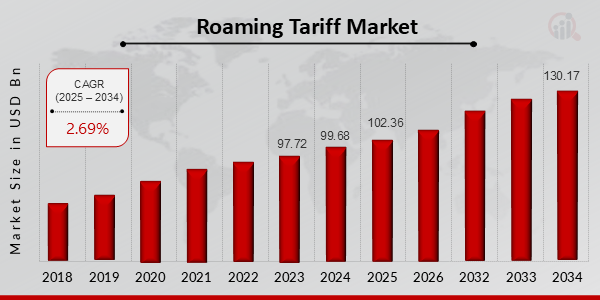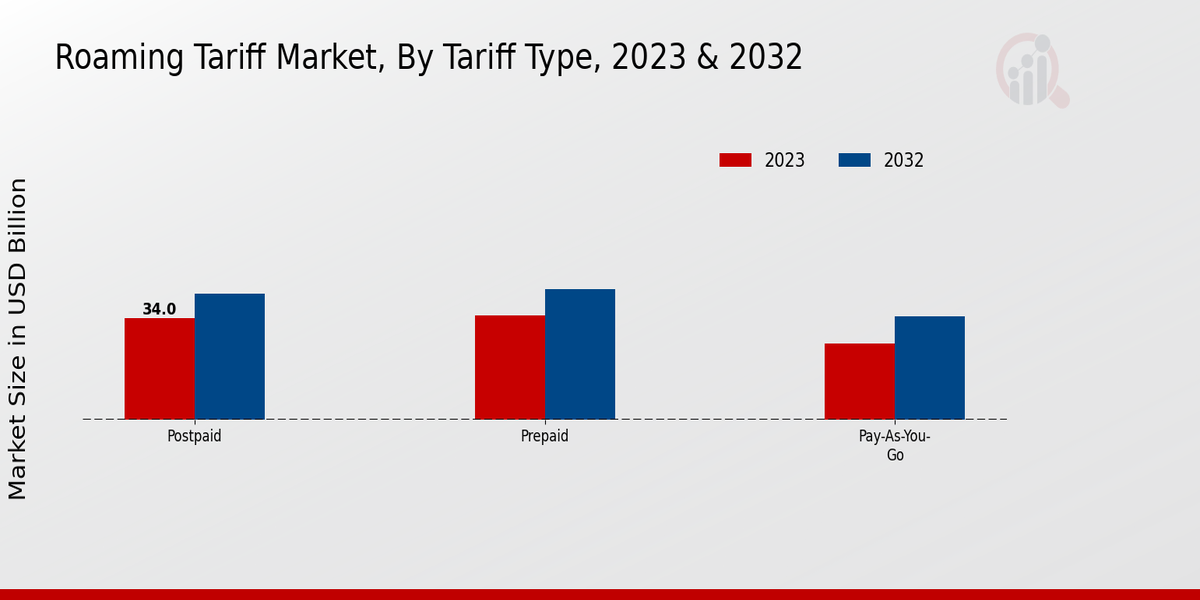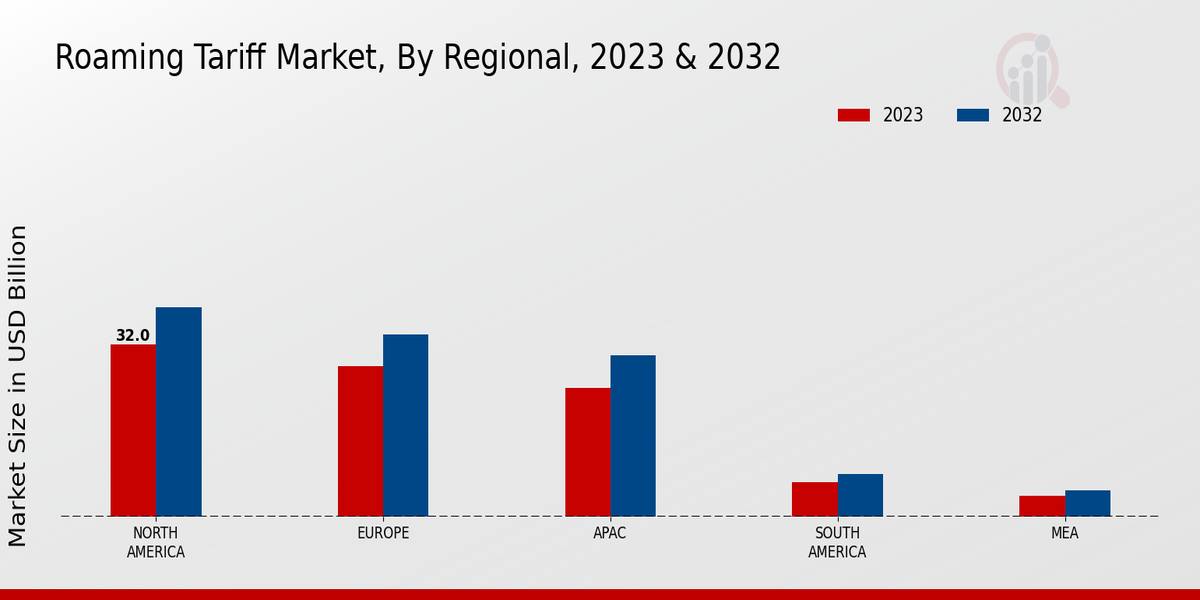Roaming Tariff Market Overview
Roaming Tariff Market is projected to grow from USD 102.36 Billion in 2025 to USD 130.17 Billion by 2034, exhibiting a compound annual growth rate (CAGR) of 2.69% during the forecast period (2025 - 2034). Additionally, the market size for Roaming Tariff Market was valued at USD 99.68 billion in 2024.
Key Roaming Tariff Market Trends Highlighted
The Roaming Tariff Market is influenced by several key market drivers that shape its dynamics. A significant driver is the expansion of international travel and globalization, which increases the demand for seamless communication while abroad. Advancements in technology, such as the rollout of 5G networks and Wi-Fi calling, also play a crucial role in shaping this market, allowing consumers to stay connected with better speeds and lower latency. Furthermore, changing regulations in various countries promote fairer pricing policies, encouraging competition among service providers, which can lead to more attractive tariff plans for consumers.
There are numerous opportunities to be explored within the Roaming Tariff Market. The ongoing digital transformation creates avenues for service providers to offer innovative roaming packages that cater to specific consumer needs, such as tailored plans for business travelers or family packages that reduce costs for group travel. Additionally, partnerships between telecom operators and local businesses can enhance the customer experience, offering promotions or local insights that add value for travelers. Emerging markets present another area of opportunity, as they often become increasingly important sources of customer growth in the coming years.
In recent times, trends such as the growth of eSIM technology have gained traction, offering a more flexible approach for consumers to manage their mobile services while traveling. Customers are also increasingly seeking transparency in pricing, with a preference for clear and predictable billing. The rise of data-heavy applications and mobile usage while traveling further influences the development of new data-centric roaming plans, promoting competition among providers to deliver attractive rates. As consumers become more tech-savvy and informed about their choices, telecom companies must adapt quickly to meet these evolving demands while remaining competitive in the market.
Figure1:Roaming Tariff Market, 2025 - 2034

Source: Primary Research, Secondary Research, MRFR Database and Analyst Review
Roaming Tariff Market Drivers
Increasing Global Tourism and Business Travel
The Roaming Tariff Market Industry is significantly driven by the increasing trends of global tourism and business travel. As economic globalization continues to flourish, international travel is becoming more accessible, allowing individuals and businesses to explore new opportunities across borders. The expansion of low-cost airlines and the consequent rise in travel frequency have created a scenario where consumers are constantly on the move, whether for leisure or corporate purposes. With the world becoming more interconnected, travelers require seamless communication capabilities, prompting the need for effective roaming tariffs that cater to their requirements while still being cost-effective. The rising cases of digital nomadism and remote working arrangements further add to the demand for flexible roaming options as individuals operate from various global locations. As the travel industry rebounds, supported by pent-up demand from the pandemic era, growth in the Roaming Tariff Market industry can be anticipated. Providers that offer attractive roaming packages with transparent pricing and various service bundles are likely to gain a competitive advantage, illustrating a direct correlation between travel trends and the growth potential in the roaming tariff space.
Advancements in Mobile Technology
Technological advancements in mobile communications are another pivotal driver of the Roaming Tariff Market Industry. The rollout of 5G networks promises faster data speeds and enhanced service capabilities, which are appealing to consumers traveling internationally. As mobile phone technology continues to evolve, so does the way users connect and access their favorite services while roaming. Enhanced mobile applications and services allow travelers to utilize their devices more efficiently abroad, leading to a greater reliance on roaming tariffs. Service providers are adapting their offerings to accommodate these changes by providing more comprehensive and user-friendly packages that meet the expectations of tech-savvy travelers.
Increased Competition Among Telecom Operators
The Roaming Tariff Market Industry is also propelled by increased competition among telecom operators. As more players enter the market and existing companies expand their service offerings, the need for competitive and tailored roaming packages becomes essential. Companies are improving their pricing strategies and customer service, aiming to attract travelers who prioritize affordability and value during their trips abroad. This competitive landscape drives innovation, leading to improved technological integrations and more appealing tariffs for consumers navigating the challenges of international communications.
Roaming Tariff Market Segment Insights
Roaming Tariff Market Tariff Type Insights
The Roaming Tariff Market, with its anticipated valuation of 94.52 USD Billion in 2023, provides a diverse landscape through its segmentation by Tariff Type, which comprises Postpaid, Prepaid, and Pay-As-You-Go options. Each of these types caters to unique consumer preferences and spending habits, crucially impacting the overall market dynamics. The Postpaid segment, valued at 34.0 USD Billion in 2023, demonstrates considerable strength as many consumers prefer the convenience of deferred payments and bundle services, making it the second-largest segment within the Tariff Type framework.
The projection of 42.0 USD Billion by 2032 indicates ongoing demand, driven by the need for seamless connectivity among frequent travelers, business personnel, and expatriates, for whom predictable billing is vital. Prepaid, on the other hand, holds a significant position with a valuation of 35.0 USD Billion in 2023 and is expected to grow to 43.5 USD Billion by 2032. The popularity of the Prepaid option stems from its inherent flexibility, allowing users to pay in advance and avoid unexpected roaming charges, which appeals to budget-conscious consumers.
This segment often dominates among occasional travelers and tourists who prefer to control their spending during international visits. The Pay-As-You-Go segment, while smaller with a value of 25.52 USD Billion in 2023, also plays a vital role in the market. Expected to rise to 34.5 USD Billion by 2032, it caters to those who seek an ad-hoc approach, limited commitments, and the assurance of only paying for what is used, appealing to infrequent travelers and those wary of subscription models. Overall, the diverse preferences across these tariff-type segments highlight varying consumer behaviors and needs, reflected in the Roaming Tariff Market revenue trends.Understanding the segmentation's intricacies contributes to a more profound insight into the Roaming Tariff Market data and provides valuable perspectives on Roaming Tariff Market Statistics, market growth, and the evolving landscape within the Roaming Tariff Market industry.
Figure2: Roaming Tariff Market, By Application, 2023 & 2032

Source: Primary Research, Secondary Research, MRFR Database and Analyst Review
Roaming Tariff Market Service Type Insights
The Roaming Tariff Market encompasses a range of service types, significantly impacting how consumers engage with communication services while traveling internationally. As of 2023, the market has reached a valuation of 94.52 billion USD and is expected to grow steadily. Within this landscape, services such as Voice Calls, SMS Services, Data Services, and Combination Plans play crucial roles. Voice Calls remain a vital part of the market, as travelers often prioritize easy communication abroad. SMS Services provide cost-effective solutions for quick updates, which appeals to many users. Data Services have gained substantial traction, reflecting the increasing reliance on smartphones for online access, social media, and navigation. Combination Plans are emerging as a preferred choice for consumers seeking comprehensive packages that cater to various needs, ensuring connectivity without overspending. These service types reflect the trends of globalization and heightened connectivity, driving market growth and offering opportunities for providers to innovate and enhance their offerings based on consumer behavior. The evolving nature of these services showcases their significance in the overall Roaming Tariff Market statistics and segmentation, positioning them as essential elements of the industry’s dynamics.
Roaming Tariff Market Customer Segment Insights
The Roaming Tariff Market, valued at 94.52 billion USD in 2023, showcases significant dynamics within its Customer Segment. This segment is primarily characterized by three key groups: Individual Consumers, Business Enterprises, and Tourists. Individual Consumers play a crucial role as they often seek affordable and convenient roaming options that cater to their personal travel needs. Meanwhile, Business Enterprises tend to dominate the market due to their demand for reliable connectivity during international operations, often requiring tailored plans that ensure seamless communication. The Tourist group represents another significant portion, as they require flexible and competitive roaming tariffs while traveling, which also drives innovation within service offerings. The interplay of these segments illustrates how evolving consumer demands and international travel trends impact the Roaming Tariff Market revenue and overall market growth. With the rise in global travel and mobile connectivity, the market is witnessing an increased focus on developing attractive tariff packages that address the specific needs of these consumer groups, further enhancing market segmentation and opportunities.
Roaming Tariff Market Pricing Model Insights
The Roaming Tariff Market, valued at 94.52 billion USD in 2023, is witnessing a steady evolution within the Pricing Model segment, which includes various approaches such as Flat Rate, Capacity Based, Usage Based, and Subscription models. Each of these models presents unique advantages that cater to different customer needs and consumption patterns. The Flat Rate model is increasingly appealing for travelers seeking predictable costs, while the Capacity-based approach enables operators to manage network resources efficiently, thus balancing user load. Usage-based methods cater to those who prefer paying only for what they consume, making it a flexible choice for infrequent travelers. Meanwhile, Subscription models offer value for regular users by providing a suite of services for a monthly fee, fostering customer loyalty. Additionally, the Roaming Tariff Market data illustrates a growing trend towards tailored and competitive pricing strategies driven by consumer demand for transparency and better service. This dynamic Pricing Model segment is expected to play a crucial role in the overall market growth, reflecting changing consumer behaviors and advances in technology.
Roaming Tariff Market Regional Insights
The Roaming Tariff Market, valued at 94.52 USD Billion in 2023, showcases significant regional variances. North America dominates this landscape with a valuation of 32.0 USD Billion, reflecting strong consumer demand for international connectivity and higher disposable incomes. Europe follows closely with a market size of 28.0 USD Billion, benefiting from stringent regulations promoting fair roaming charges and a deeply interconnected mobile network. The APAC region, holding a valuation of 24.0 USD Billion, also exhibits rapid growth driven by increasing smartphone penetration and travel activities. In contrast, South America and MEA, with valuations of 6.52 USD Billion and 4.0 USD Billion, respectively, represent smaller but emerging markets, primarily influenced by the rising tourism sector and improving telecom infrastructure. Overall, the Roaming Tariff Market segmentation highlights the dominance of North America and Europe while revealing emerging potential in APAC, South America, and MEA. This diverse market landscape offers growth opportunities corresponding to evolving consumer needs and technological advancements, driving the industry toward progressive transformation.
Figure3: Roaming Tariff Market, By Regional, 2023 & 2032

Source: Primary Research, Secondary Research, MRFR Database and Analyst Review
Roaming Tariff Market Key Players and Competitive Insights:
The Roaming Tariff Market is an increasingly dynamic sector characterized by intense competition among telecommunications providers as they strive to offer more attractive services to meet the evolving needs of consumers and enterprises. With globalization driving travel and the need for connectivity beyond borders, roaming services have become essential for users who rely on seamless communication while abroad. This evolving landscape sees companies adopting innovative strategies, leveraging technology to enhance customer experiences, and optimizing pricing models to attract a broader customer base. The competition is heightened by regulatory changes, advancements in mobile technology, and the growing demand for data services, prompting companies to adapt quickly to stay relevant in the marketplace. In this context, understanding the strengths and positioning of leading market stakeholders is crucial for grasping the competitive dynamics at play.
Telefonica emerges as a prominent player in the Roaming Tariff Market with a robust international presence bolstered by its extensive network infrastructure and partnerships. The strength of Telefonica lies in its commitment to delivering innovative roaming solutions that cater to the diverse needs of its customer segments, consistent with the company's emphasis on quality and reliability. It offers a variety of roaming plans, allowing customers to choose options that align with their travel habits, thereby enhancing their overall experience. Its strategic focus on expanding its global footprint through collaborations with other operators enables Telefonica to provide competitive tariffs and services, ensuring seamless connectivity for its users regardless of their location. The company's reputation for strong customer service further solidifies its position in the market, making it a preferred choice for many travelers.
Vodafone stands out in the Roaming Tariff Market through its well-established brand and wide-reaching presence. The company offers a range of competitive roaming solutions designed to meet the diverse requirements of its customer base, including both casual travelers and business users. Vodafone's strength lies not only in its attractive pricing models but also in its commitment to transparency in roaming charges, allowing users to make informed decisions while traveling. The introduction of innovative features like bundle packages and flexible data plans has positioned Vodafone favorably among consumers seeking to balance cost with convenience. Additionally, Vodafone actively engages in partnerships with local operators across various countries, ensuring that its customers enjoy quality services and reliable connectivity while abroad. This strategy, combined with its experienced approach to customer support, enhances Vodafone's competitive edge in the global roaming space.
Key Companies in the Roaming Tariff Market Include
- Telefonica
- Vodafone
- Etisalat
- NTT Docomo
- TMobile
- SoftBank
- Sprint
- China Mobile
- Telstra
- MTN Group
- Orange
- Verizon
- AT and T
- Deutsche Telekom
- BT Group
Roaming Tariff Market Industry Developments
The Roaming Tariff Market has seen significant recent developments with companies like Vodafone and AT&T announcing new competitive roaming packages aimed at improving customer experiences for travelers. Telefonica is also in the spotlight, enhancing its roaming agreements across Europe to facilitate seamless connectivity. Meanwhile, Deutsche Telekom has been actively expanding its partnerships in the Asia-Pacific region, leveraging its global network to enhance service delivery for international travelers. Mergers and acquisitions in the sector include T-Mobile's consolidation efforts to gain a stronger foothold in the U.S. market, while SoftBank is exploring strategic partnerships in Asia, aiming to streamline international roaming services. Current growth in the market is influenced by increasing smartphone penetration and the demand for affordable data plans abroad, with companies like Verizon and China Mobile investing heavily in network expansions to accommodate this trend. Overall, the ongoing transformations and competitive strategies adopted by major players like MTN Group, Orange, and BT Group are reshaping the landscape, driving both innovation and consumer choice in the Roaming Tariff Market.
Roaming Tariff Market Segmentation Insights
- Roaming Tariff Market Tariff Type Outlook
- Postpaid
- Prepaid
- Pay-As-You-Go
- Roaming Tariff Market Service Type Outlook
- Voice Calls
- SMS Services
- Data Services
- Combination Plans
- Roaming Tariff Market Customer Segment Outlook
- Individual Consumers
- Business Enterprises
- Tourists
- Roaming Tariff Market Pricing Model Outlook
- Flat Rate
- Capacity Based
- Usage Based
- Subscription
- Roaming Tariff Market Regional Outlook
- North America
- Europe
- South America
- Asia Pacific
- Middle East and Africa
|
Report Attribute/Metric
|
Details
|
|
Market Size 2024
|
99.68 (USD Billion)
|
|
Market Size 2025
|
102.36 (USD Billion)
|
|
Market Size 2034
|
130.17 (USD Billion)
|
|
Compound Annual Growth Rate (CAGR)
|
2.69% (2025 - 2034)
|
|
Report Coverage
|
Revenue Forecast, Competitive Landscape, Growth Factors, and Trends
|
|
Base Year
|
2024
|
|
Market Forecast Period
|
2025 - 2034
|
|
Historical Data
|
2019 - 2023
|
|
Market Forecast Units
|
USD Billion
|
| Key Companies Profiled |
Telefonica, Vodafone, Etisalat, NTT Docomo, TMobile, SoftBank, Sprint, China Mobile, Telstra, MTN Group, Orange, Verizon, AT and T, Deutsche Telekom, BT Group |
| Segments Covered |
Tariff Type, Service Type, Customer Segment, Pricing Model, Regional |
| Key Market Opportunities |
5G deployment expansion, E-sim technology adoption, Increased mobile data consumption, Personalization of roaming plans, Emerging markets penetration |
| Key Market Dynamics |
increasing mobile data usage, regulatory changes in tariffs, competition among telecom operators, technological advancements, customer demand for transparency |
| Countries Covered |
North America, Europe, APAC, South America, MEA |
Frequently Asked Questions (FAQ) :
The Roaming Tariff Market is expected to be valued at 130.17 USD Billion in 2034.
In 2023, the Roaming Tariff Market is valued at 97.72 USD Billion.
The expected CAGR for the Roaming Tariff Market from 2025 to 2034 is 2.69%.
North America holds the largest market share in the Roaming Tariff Market with a value of 32.0 USD Billion in 2023.
Europe's market size in the Roaming Tariff Market is projected to reach 34.0 USD Billion by 2032.
Major players in the Roaming Tariff Market include Telefonica, Vodafone, Etisalat, and TMobile, among others.
The Pay-As-You-Go tariff type is expected to reach a market size of 34.5 USD Billion by 2032.
The Prepaid tariff type is valued at 35.0 USD Billion in 2023.
The APAC region is expected to have a market size of 30.0 USD Billion in 2032.
South America is expected to experience growth in the Roaming Tariff Market, reaching a size of 8.0 USD Billion by 2032.

















